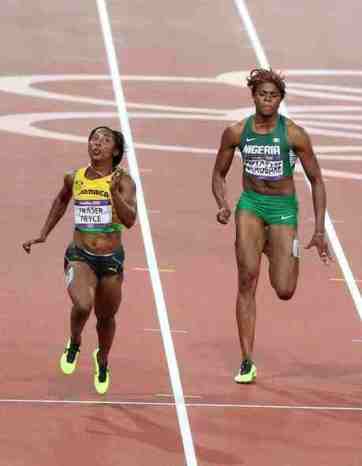Deconstructing the Height Hype in Female Sprinters
Airnel T. Abarra*

5’0 Fraser Pryce Olympic Womens 100m Champion beating 5’11 Nigerian Blessing Ogkabre.
Look at the physical development somatype of Fraser Pryce with larger glutes and quads which may be a result of genetics giving more advantage than height in the short sprints.
It is always common maxim that the taller the athlete, the better. In a basketball fanatic-
country like the Philippines, mainstream sports media mostly portray tall athletes on a
positive light while shorter ones are only get noticed when they have shown higher points
and still put on a comical perspective when citing the latter’s performance. In Athletics,
100m sprints have been the gold standard for the fastest athlete. For more than
20 years, Philippines haven’t won the gold medal in Asian Games in the 100m distaff race.
Do we think that our female athletes are short enough not to win the female century dash in
Asiad?
Let us try a mini-meta analysis on different studies about the topic.
In relation to the anthropometric measurement of sprinters, Uth (2005) found out that there
are no optimal height for sprinters thus being too tall or too short can be a disadvantage.
Watts et. al. (2012) on the other hand proved that the body shape or somatotype of the athlete
in sprinting should be the basis for selecting potential athletes. Shorter athletes have also
powerful strides on shorter races and can move to a greater frequency whereas tall sprinters
runs faster in the longer sprint races. (Schiffer, 2009)
It also implied that stride frequency among women which is greater to “shorter†sprinters is
significant in better performance in the sprints. Stressing that “shorter women†of stronger
build performs faster and suggested that coaches should focus their training programs in
enhancing the female athlete’s stride frequency. (Paruzel-Dyja et. al. 2006)
The problem of taller female sprinters relies on the excessive lateral movement resulted from
taller structure and with wider hips causes them more lateral displacement while running
and the center of the gravity travels on an “S†shape pattern during acceleration thus having a
taller woman sprinter can be a disadvantage even if someone can is as tall like Usain Bolt at
196cm.
The studies reviewed shows that height is not always a gold standard for the success of
female sprinter. It is still dependent on the sprinting form and technique which is rooted to
different principles of Biomechanics. It is also seen in the studies presented that strength and
conditioning is more important in improving the sprinting capability of an athlete as
compared to paying attention to the athlete’s height.
This “hype†for taller athlete can be traced as well on how we see our sporting culture in the
Philippines. The portrayal of the popular culture that BEING tall as a sign of sound body
beats the purpose of diversity among athletes. As coaches, we should go away from
perceptions and rely on data from different studies with doing talent identification and
organizing the training programs, especially for female athletes.
Comments are welcome by contacting the author at [email protected]
References:
Paruzel-Dyja, M. Walaszcyk, A. & Iskra J. (2006) Elite Male and Female Sprinters’ Body Build, Stride Length, and Stride Frequency. Studies in Physical Culture and Tourism. University School of Physical Education in Katowice, Poland. 13, 1, 33-37
Schiffer, J (2009) The Sprints New Studies In Athletics by International Association of Athletics Federations. 24:1 7-17
Uth, N. (2005) Anthropometric Comparison of World-Class Sprinters and Normal Populations. Department Of Sport Science, University Of Aarhus, Aarhus N, Denmark - Journal Of Sports Science And Medicine (2005) 4, 608-616
Valcicak, D. and LoRusso S. (2013) Spectrum: Journal of Student Research at St. Francis University, Loretto, PA . 3, 4-11
Watts, AS, Coleman, I & Nevill, A (2012) The changing shape characteristics associated with success in world-class sprinters. Journal of Sports Sciences . Vol. 30, Iss. 11, 2012
*- Airnel T. Abarra is currently a part-time faculty member at the Department of Physical Education- Ateneo de Davao University and Head Coach of the Track Team of the said school. Also Mr. Abarra is one of the pioneering writers of PinoyAthletics.info


